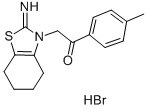Description
Pifithrin-
α is an inactivator of p53 that blocks p53-
dependent transcriptional activation and apoptosis. It prevents p53-
mediated apoptosis induced by cytotoxic compounds in C8 cells at 10 μM and in human umbilical vein endothelial cells at 30 μM. Pifithrin-
α can also protect cells from DNA damage-
induced apoptosis by a p53-
independent mechanism that might involve cyclin D1.
Characteristics
Pifithrin-α is an inhibitor of p53, inhibiting p53-dependent transactivation of p53-responsive genes. Pifithrin-α is also a potent agonist of the aryl hydrocarbon receptor (AhR).
Uses
Pifithrin-α has been used:
- to study the effect of specific p53 inhibitor on p53-upregulated modulator of apoptosis (PUMA) expression after transient global cerebral ischemia (tGCI)
- as p53 inhibitor to treat PA1 cells
- as a tumor protein p53 (TRP53) inhibitor, to treat mouse lung epithelial-12 (MLE-12) cells
General Description
A cell-permeable chemical inhibitor of p53. Reversibly inhibits p53-dependent transactivation of p53-responsive genes and reversibly blocks p53-mediated apoptosis. Inhibits p53-dependent growth arrest of human diploid fibroblasts in response to DNA damage but has no effect on p53-deficient fibroblasts. Protects normal tissues from the deleterious side effects of chemotherapy. Has been reported to protect neurons against β-amyloid peptide and glutamate-induced apoptosis.
Biological Activity
Inhibitor of p53; reversibly blocks p53-dependent transcriptional activation and apoptosis. Protects against neuronal death in models of stroke and neurodegenerative disorders. Active in vivo ; protects mice from the side-effects of cancer therapy associated with p53 induction. Potentially increases reprogramming efficiency of human somatic cells to induced pluripotent stem cells (iPSCs) by silencing p53. Also aryl hydrocarbon receptor (AHR) agonist, causes upregulation of AHR target gene CYP1A1 (EC 50 = 1.1 μ M).
Biochem/physiol Actions
Pifithrin-α is a reversible inhibitor of p53-mediated apoptosis and p53-dependent gene transcription such as cyclin G, p21/waf1, and mdm2 expression. Pifithrin-α enhances cell survival after genotoxic stress such as UV irradiation and treatment with cytotoxic compounds including doxorubicin, etopoxide, paclitaxel, and cytosine-β-D-arabinofuranoside. Pifithrin-α protects mice from lethal whole body γ-irradiation without an increase in cancer incidence. The protective effect is not seen in p53-null mice or cells expressing a dominant negative mutant of the p53 gene. Protection is conferred by the transient expression of p53 in p53-deficient cell lines.
in vitro
Pifithrin-α inhibits p53-dependent transactivation of p53-responsive genes in ConA cells. Pifithrin-α (10 μM) inhibits apoptotic death of C8 cells induced by Dox, etoposide, Taxol, cytosine arabinoside. Pifithrin-α inhibits p53-dependent growth arrest of human diploid fibroblasts in response to DNA damage but has no effect on p53-deficient fibroblasts. Pifithrin-α may modulate the nuclear import or export (or both) of p53 or may decrease the stability of nuclear p53. Pifithrin-α (100-200 nM) completely suppresses the camptothecin-induced increase in the level of p53 DNA binding as well as the p53-responsive gene Bax in hippocampal cell. Pifithrin-α also decreases the basal level of p53 DNA-binding activity. Pifithrin-α (200 nM) protects cultured hippocampal neurons against death induced by DNA-damaging agents. Pifithrin-α (200 μM) stabilizes mitochondrial function, suppresses caspase activation and protects cultured hippocampal neurons against death induced by glutamate and amyloid β-peptide. Pifithrin α, in addition to p53, can suppress heat shock and glucocorticoid receptor signaling but has no effect on nuclear factor-kappaB signaling. Pifithrin α (10 μM) reduces activation of heat shock transcription factor (HSF1) and increases cell sensitivity to heat. Pifithrin α (10 μM) reduces activation of glucocorticoid receptor and rescues mouse thymocytes from apoptotic death after dexamethasone treatment in HeLa cells. PFTalpha blocks p53-mediated induction of p21/Waf-1 in human embryonic kidney cells. PFTalpha does, however, cause a left shift in the dexamethasone dose response curve by increasing intracellular dexamethasone concentration.
in vivo
Pifithrin-α (2.2 mg/kg i.p.) treatment completely rescues mice (C57BL and Balb/c) of both strains from 60% killing doses of gamma irradiation (8 Gy for C57BL and 6 Gy for Balb/c). Pifithrin-α-injected mice lost less weight than irradiated mice that are not pretreated with the Pifithrin-α. Pifithrin-α (2.2 mg/kg) abrogates p53-dependent regulation of DNA replication after whole-body gamma irradiation in mice. Pifithrin-α (2 mg/kg i.p.) 30 min prior to middle cerebral artery occlusion treatment of mice reduces ischemic brain injury and protects hippocampal neurons against excitotoxic injury. Pifithrin α (3.6 μg/kg i.p.) inhibits Dex-induced degeneration of the thymus in mice. Pifithrin α (2 mg/kg) results in a significantly lower degree of motor disability in rats receiving transient occlusion of the middle cerebral artery as compared with controls. Pifithrin α-treated animals has less motor disability and smaller infarcts when the drug is administered up to an hour after stroke onset. Pifithrin α results in significantly lower motor disability scores in rats than in the vehicle-treated animals at 7 days post-op. Pifithrin α results in significant reduction of apoptosis in rats as indicated by Tunel and caspase 3 staining.
storage
-20°C (desiccate)
References
1) Komarov et al. (1999), A chemical inhibitor of p53 that protects mice from the side effects of cancer therapy; Science, 285 1733
2) Komarova and Gudkov et al. (2000), Suppression of p53: a new approach to overcome the side effects of antitumor therapy; Biochemistry, 65 41
3) Culmsee et al. (2001), A synthetic inhibitor of p53 protects neurons against death induced by ischemic and excitotoxic insults, and amyloid-peptide; J. Neurochem., 77 220
4) Hoagland et al. (2005), The p53 inhibitor pifithrin-α is a potent agonist of the aryl hydrocarbon receptor; J. Pharmacol. Exp. Ther., 314 630
5) Abdelalim and Tooyama (2012), The p53 inhibitor, pifithrin-α, suppresses self-renewal of embryonic stem cells; Biochem. Biophys. Res. Comm., 420 605


